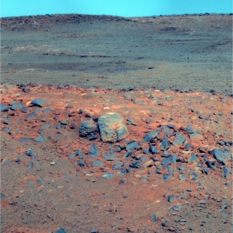A.J.S. Rayl • Apr 07, 2014
Mars Exploration Rovers Update: Opportunity Powers Up in Cook Haven and in Fans' Minds
Sols 3590 – 3621
At the Solander Point section of the rim of Endeavour Crater, Mars Exploration Rover Opportunity spent the month of March just off Murray Ridge working on its final targets in Cook Haven and dusting itself in the winds of winter, while MER mission officials on Earth were roving toward what may be the robot's current greatest potential threat – being cut from NASA's planetary science budget.

Mars Exploration Rover
NASA / JPL-Caltech / Maas Digital
The MER operations team remained focused on Opportunity not politics in recent weeks and for good reason. The winds that whipped up from the 22-kilometer (13.67-mile) diameter hole in the ground blew through Cook Haven throughout the month enabled the robot field geologist to shake the dust of sols gone by and in an almost unprecedented way power up for the trek to the next geologic 'goldmine' 600 meters to the south.
More than a decade into what was originally a 90-day mission, Opportunity is emerging from a Martian winter with the energy of a kid rover. This veteran robot's energy rocketed 150 watt-hours in March, jumping from 492 watt-hours to 642 watt-hours, despite the fact that it had just emerged from the depths of winter in February. "The exciting news is that the rover's solar power production is now at 86% performance," reported John Callas, MER project manager at JPL. "This is the highest level we've had in winter since the first winter on Mars."
The rover's current solar power production is nearly two-thirds of its total capability of about 1050 watt-hours. "Opportunity is doing exceptionally well," said Bill Nelson, chief of MER engineering at the Jet Propulsion Laboratory (JPL), home to all of NASA's Mars rovers. "We're now facing the situation where we have so much energy and can do so many activities that we're starting to take more data than we can get back to Earth," he said. "This is a good problem to have."
For the last couple of months, Opportunity seems to have been in the right place at the right time. In the gentle valley of Cook Haven, bedrock is clearly exposed and the ubiquitous dust of Mars is obviously less prevalent. "I think it's a scour zone, where winds are coming out of the crater and then scouring the bedrock and the tops of the solar panels to boot," said Ray Arvidson, deputy principal investigator, of Washington University St. Louis.

A nice dusting
Opportunity took this picture of a small part of its solar array with its panoramic camera (Pancam) in March 2014, just after a significant dust clearing that improved the rover's solar power production by 10%. You can see the once shiny black arrays seem to be clear of contamination, although the rusty red Martian dust has pooled in the crevices between arrays. That little yellow "button" by the way is a bumper that kept the arrays from hitting each when folded up for flight and landing. A new deck pan, or "selfie," is to be released in April.NASA / JPL-Caltech / Cornell / ASU
While the rover engineers had been observing a slow, gradual improvement since late January, with the additional two declared dust-cleaning events in March, each boosting power levels by about 10%, Opportunity's newfound energy still seems as remarkable in winter as it was welcomed. "This puts us in really good shape for the next couple of years," summed up Callas.
The MER science team already knows exactly where it wants Opportunity to go during the next two years. For months now, science team members have had their sights set on a location 550 to 600 meters to the south, depending on which way the rover drives. Past that, another 2500 meters to the south is one of the mission's major, much-anticipated science destinations, Cape Tribulation, which actually has topped the list of most-wished-for attractions since before the rover arrived at Endeavour in August 2011.
Cape Tribulation is harboring an accessible mother lode of smectites, stratigraphy and other really ancient, Noachian Period stuff from 3 to 4 billion years ago, according to detections made by the Compact Reconnaissance Imaging Spectrometer for Mars (CRISM), onboard the Mars Reconnaissance Orbiter (MRO). The rover is genuinely in the midst of a whole new mission investigating the most ancient landscapes any Mars rover has ever traversed.
But as Opportunity was soaking up the Sun on Mars and feeling the wind beneath her winglets, a dark cloud seemed to be forming over the mission. At the 45th annual Lunar & Planetary Science Conference (LPSC), held in The Woodlands, Texas, attendees were concerned and confused about the fate of Opportunity and the Lunar Reconnaissance Orbiter (LRO), both of which – in a table that was released along with NASA's Fiscal 2015 Planetary Sciences budget – were zeroed out in 2015.
"I recognize there's lot of misunderstanding," said the space agency's Planetary Science Division Director Jim Green, during an often highly animated question-answer session at the NASA night presentation March 17th. "The President provides a budget for which all our operating missions are covered. They are covered in two parts of budget: the main part is the OMB's [Office of Management and Budget's] budget for the Planetary Sciences Division. The other is $35 million dollars is [from] the President's Opportunity, Growth and Security Initiative. That's where the total funding is. Congress has to make a decision," he said.
The President's Opportunity, Growth and Security Initiative is a $56-billion-dollar proposed fund – "fully paid for with a balanced package of reforms," according to official documents – to be used for "investments in education; research and innovation; infrastructure and jobs; opportunity and mobility; public health, safety, and security."
To continue full-time ops, the MER mission needs – and is requesting in its proposal to the Senior Review – funding of around $14.5 million dollars annually for the next two Earth years, according to one inside source. Because MER team members don't want to appear to be lobbying in any way, the source requested anonymity. However, this $14.5 million dollar figure is consistent with recent annual ops costs.
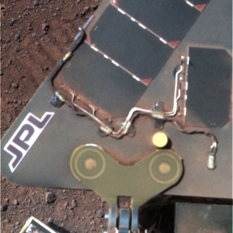
A little advertising
With all the dusting it received in March, Opportunity is clean enough now that the logo of its birthplace, JPL, is clearly visible. As clean as the solar cells next to that logo look, there is a certain amount of electrostatically bound dust no the cells that will never be whisked away. The shine of newness may never return, but right after the rover took this and other pictures for its new self-portrait, the very next Martian day or sol the wind blew again and pushed power levels to the highest this rover has ever had in winter since its very first winter on Mars, back in 2004-2005.NASA / JPL-Caltech / Cornell / ASU
"So, let's speculate and say Congress says 'no' to the Opportunity [rover] fund," Green continued. "What are we going to do?"
Historically, each planetary mission seeking an extension submits a proposal to a biannual Senior Review, a committee chosen by NASA to determine the best missions to pursue. Nothing changes on that front. NASA will follow that tradition, Green said. "We'll order the missions, we'll make programmatic decisions, and we'll fund them," he said. "If LRO is on top or Opportunity is on top, they will be funded. We will re-program as necessary to be able to cover these missions."
Still, the table is there for all to see with Opportunity and those zeros, and it has been confusing, even for some MER team members.
"You may have answered this, but I want to be more direct in how it's stated," ventured Steve Ruff, a member of the MER science team who served as the science lead on the Mini-TES on Spirit. "Right now in NASA's budget, Opportunity is zeroed out in 2015, even before the Senior Review –."
"That's not correct," interjected Green.
"Well there's a table –" Ruff said, citing the aforementioned table.
"That is not correct," Green insisted. "The President's budget has two parts to it. Those two parts are on the planetary line and also in the new initiatives. Opportunity's budget is in the new initiatives," he reiterated.
"Which is this still-unconfirmed possibility, because Congress has to –?" Ruff asked, seeking clarification.
"How this goes [is] the Administration develops the budget and provides it to Congress," said Green, talking about President Obama's Fiscal Year 2015 budget. "Congress considers the Administration's position and puts together another budget and passes that. And that is the budget we will execute."
"So why does this table show zeros for Opportunity and LRO and not other missions?" pressed Ruff.
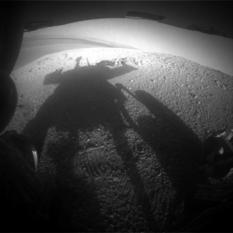
A big shadow
Late on the afternoon of her Sol 3609 (Mar. 20, 2014), Opportunity captured her silhouette with the rear hazard avoidance camera. The image was taken looking eastward shortly before sunset and the rover's shadow falls across the McClure-Beverlin Escarpment on the western rim of Endeavour Crater, where the robot field geologist is investigating rock layers for evidence of ancient environments. The camera is mounted low on the rover and has a wide-angle lens allowing for a glimpse into the distance, across the 2-kilometer-wide (13.67-mile) diameter crater.NASA / JPL-Caltech
"What mission would you like for me to put there?" retorted a seemingly frustrated Green.
Many planetary scientists in the audience, likewise frustrated, laughed. Obviously it would be politically incorrect for any one, especially a NASA official, to single out another mission for the guillotine. But therein lies the budgetary rub. Basically all of NASA's planetary missions are worthy. Which still doesn't explain why Opportunity and LRO were on the table and zeroed out in 2015.
"We are working very hard to give our extended missions the opportunity to do the next set of great science," Green continued in response to Ruff's concern. "I would love to have the community not worry so much about where the money is and how much they'll get, because they first need to write a proposal to get it." His suggestion: "[W]rite the best darn extended mission proposal such that our peer review process will allow us then to fund them."
"That's certainly the intent with Opportunity," Ruff responded. "I just wanted to hear from you that it's still very much in the competition –"
"Absolutely," said Green, emphatically adding a question of his own: "You didn't see me in Ray Arvidson's first talk on great discoveries from Opportunity?"
Indeed Green was there. This MER scribe sat behind him.
One could argue that how MER gets funded is not important and that what's important is it does get funded. Even if, hypothetically, a Senior Review committee decides it's no longer interested in Opportunity – which would be an extreme stretch unless there were no planetary scientists on the committee but stranger things have happened – and Congress also says "no," it likely wouldn't be the last you heard of the legendary, longest-lived rover on Mars.
Chances are better than good that the public would respond – not favorably – to shutting down what is, arguably, the most popular NASA mission since Apollo, much like it responded and turned things around when the agency made moves to terminate Voyager in 2005, scrap the Hubble Space Telescope in 2006, and when a NASA official threatened to force Spirit into what probably would have been a permanent hibernation in 2008.
Today, the twin Voyagers continue flying, with V1 now in interstellar space! Hubble was repaired in 2009, and is still taking breathtaking images of the universe, And, Spirit lived to her end, dying sometime during the Martian winter of 2010, no one knows for sure why.
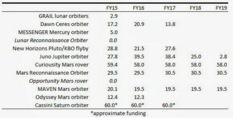
A confusing table
Pay no attention to the table, suggested Jim Green, director of the Planetary Science Division at NASA Headquarters. "The President provides a budget for which all our operating missions are covered," he assured during the 45th annual Lunar & Planetary Science Conference held in March in Texas. They are covered in two parts of budget: the Planetary Sciences budget; and the President's Opportunity, Growth and Security Initiative. "That's where the total funding is," he said. "Congress has to make a decision."U.S. Government
Even if Opportunity weren't brimming with power or roving – for the first time – into past landscapes and environments that will reveal much more about habitable environments on Mars, it would be worth keeping her going to see how long a rover can survive on Mars and serve as an Earth ambassador, followers argue. With Curiosity's wheels already wearing as they are, the obvious successor is no longer a safe bet to overcome MER's mileage or longevity record.
Seeing the table and those 0's does make for concern and confusion and it is not at all obvious on the face of it, especially to those who are not insiders or ploy-minded, that MER will be funded or how it will be funded. The reality is Opportunity and LRO were singled out in the actual planetary sciences budget and transitioned into another "pot" that Congress must approve.
"The fact that Opportunity was explicitly mentioned is serious," said Arvidson. "For us, as a science team and a project, it means we have to re-double our efforts to produce an outstanding extended mission proposal."
Certainly MER has all the winning elements – a healthy, viable rover at the start of a new mission to clay mineral 'goldmines' known to exist among the oldest Noachian landscapes any robot has ever traversed on Mars. "There is a lot we can see in the orbital data to the south of us, things that will blow away what we've done so far, including [the discoveries on] Matijevic Hill," Arvidson said.
Proposals for the Senior Review are due April 11th. For the most part, the MER officials are confident that Opportunity will get her extension. "We have a healthy rover with a very compelling science mission in front of is and I'm confident that that argument will carry the day," said Callas. "We're proceeding as if we are going to receive the guideline funding amount that NASA has given us."
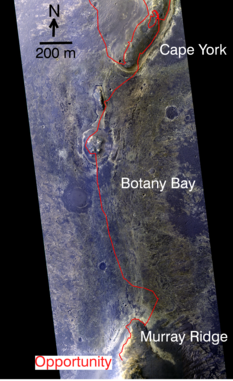
A new mission underway
This overview image shows part of the western rim of Endeavour Crater as observed by the HiRISE camera onboard the Mars Reconnaissance Orbiter (MRO). Ray Arvidson used it during his presentation at the 45th annual Lunar & Planetary Science Conference held in The Woodlands, Texas March 17-21, 2014, to illustrate the path Opportunity has followed since arriving at the big 22 km (13.67 mi) diameter crater in August 2011.NASA / JPL-Caltech / UA
The MER team is as "secure" as it has been in the past periods. "We are always subject to direction from Washington," Callas cautioned. "Not until we have the money in hand will we know for sure."
"I think it's all about whether or not we're done and it's diminishing returns or that we have found the ancient rocks and there are more of them, a whole section just 600 meters away and a mother lode just 3000 meters away, where there are probably three different kinds of clay minerals," Arvidson said. "The only way we can unravel the story here is to get down there with Opportunity and do the detailed measurements equivalent to what we did at Matijevic Hill with the Matijevic Formation."
As MER officials worked on the Senior Review proposal for what will be the ninth mission extension, Opportunity carried on undaunted and seemingly with as much purpose as ever.
When March dawned at Endeavour Crater, the rover was in an area of bedrock dubbed Cross Sound, just 5.73 meters (18.80 feet) from Stuart Island, the last target it investigated in late February. After documenting the new area with Panoramic Camera (Pancam) and Navigation Camera (Navcam) pictures, to be stitched together for large mosaics, Opportunity turned to analyzing the chemical make-up of the chosen rock targets.
The robot field geologist homed in on a rock called Turnagain Arm for an in-depth study, which included a now familiar routine of taking pictures with its Microscopic Imager (MI), analyzing the chemistry with the with the Alpha Particle X-ray Spectrometer (APXS), brushing the rock with the Rock Abrasion Tool (RAT), and then imaging it and checking the chemical composition again.
On Sol 3600 (March 10, 2014), Opportunity climbed on, uphill toward a new rock target called Augustine. The slope was steep though and the rover kept slipping. As always, she persevered and with a bump on Sol 3601 and another on Sol 3602 (March 11 and March 12, 2014), the rover edged in close enough to look at the selected target.
Amidst her rock studies, Opportunity took pictures, as always, of things and sights near and far with her PanCam and NavCam. The robot also pointed her APXS upward to take some of the routine atmospheric argon measurements for a mission-long experiment and even used her Navcam to take a set of atmospheric opacity or tau measurements to assist the InSight mission.
InSight is a lander, "terrestrial planet explorer" as its being called, based on the Phoenix platform, scheduled to touch down on Mars in 2016. "InSight doesn't have a Pancam, but it does have a NavCam, but we haven't used our NavCam to get optical depth, so we're helping them with how to determine and record optical depth with the NavCam," said Arvidson. "It's a feed forward for that mission."
Up to the middle of March, Opportunity's power levels hovering just under 500 watt-hours, but between Sols 3605 and 3606 (March 15 and March 16, 2014), a guster blew through Cook Haven and over the rover, lifting a statistically significant amount of dust from the solar arrays and resulting in about a 10% improvement in power production. Three sols later, she was producing 574 watt-hours of solar power.
"We've been seeing a gradual, somewhat erratic increase in dust factor for the past month or two, with occasional declared jumps," said Nelson. "This was the first declared jump in March."

NASA / JPL-Caltech / Cornell / ASU
McClure-Beverlin Escarpment
The boulder-studded ridge in this image was dubbed the McClure-Beverlin Escarpment in February 2014 to honor Jack Beverlin and Bill McClure. These two engineers risked their lives to save NASA's second successful Mars mission, Mariner 6, on its launch pad on Feb. 14, 1969. Opportunity, looking toward the south, took the pictures for this image with her Pancam during her Sol 3527 (Dec. 25, 2013). As March turned to April 2014, the rover was climbing the slope in search of exposed rock layers. This false color version emphasizes subtle color differences among Martian surface materials. You can see a 3D version here.Although she was raring to go, Opportunity's attempt to climb up to a target rock called Sugarloaf on Sol 3607 (March 17, 2014) didn't go as hoped. That drive stopped automatically after just 2.3 meters (7.55 feet) because three of the rover's six wheels were drawing higher than average current and she was experiencing as much as 50% slip.There was no risk of embedding in this wind-swept area, but the upward climb and approach to Sugarloaf was steep and would require multiple additional drives if the team wanted their robot to use her arm on the rock surface. The MER scientists decided they didn't want to invest the time.
Instead, the team directed the robot field geologist to take more color, Pancam pictures of Sugarloaf, then drive to new targets. "Sugarloaf is on a 20-degree slope and it was just too rocky and rough," said Arvidson, who is acting principal investigator as PI Steve Squyres took a much-needed vacation. "We decided to skirt to the southwest and stay on the lookout for interesting rocks."
On Sols 3609-3610 (March 19-20, 2014), Opportunity drove 16.35 meters (53.64 feet), then 10.89 meters (35.72 feet) respectively to the southwest. She stopped there to take the images needed for a new deck pan – a "selfie" – on Sols 3611-3612 (March 21-22, 2014). Interestingly, the rover had just taken a selfie back in January. In that one, the rover is still laden enough with the rust red dust to blend into the environment.
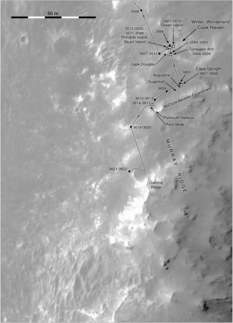
Opportunity route map
Phil Stooke has been charting Opportunity's route around Solander Point and recently posted this update, which eventually will be published in the second volume of his International Atlas of Mars Exploration. In March 2014, he detailed the rover's journey through Cook Haven and the McClure-Beverlin Escarpment and labeled it as plotted over this image of Solander Point taken by the HiRISE camera onboard MRO.NASA / JPL-Caltech / UA / Phil Stooke, University of Western Ontario
Opportunity's latest selfie, when fully processed and pieced together, will give the team and the world the chance to see just how clean this rover is now. "It looks pretty good. It really does," said Nelson on viewing the various sections. That new selfie should be released in April.
No sooner had Opportunity finished taking her latest selfie, however, when another gust of wind turned up. The gust that blew through the haven the following sol, 3613 (March 23, 2014) brushed even more dust off the rover and pushed power up by another 10%, past 625 watt-hours.
As the MER team was reviewing that data, the rover making a short 3.64-meter approach to its next rock target, Point Bede. "Another layered rock, about 8 centimeters wide, Point Bede is part of the McClure-Beverlin Escarpment complex," said Arvidson.
After bumping another 1.99 meters (about six feet) on Sol 3615 (March 25, 2014) and checking out Point Bede up close, the rover took off. She drove south/southwest 20.80 meters (68.24 feet) around the end of the escarpment to a small, still unnamed rise, on Sol 3618 (March 28, 2014), bringing her total odometry to 38.82 kilometers (24.12 miles). That's where the rover 'cooled her jets' and spent the rest of March.
Opportunity's energy however continued to increase during the final sols of March. "We're still basically in winter and we're seeing the power increase higher than it's been during any other winter, with the exception of the first winter back in 2004-2005, when the rover was producing in the range of 750 watt-hours," said Nelson. "In every other previous winter but that first one, the highest levels Opportunity produced were below 500 – although as the Martian season progressed energy rose to 600, and in some years as much as 700 watt-hours," he pointed out.
The MER team had anticipated they may see some dust clearings at Endeavour. The engineers and scientists had seen their charge gain from some minor dust cleanings around Victoria Crater, and the scientists documented wind streaks there that changed direction over time. So they knew there was wind coming out of Victoria, even though Oppy didn't happen to be at the right place at the right time to get the kind of boosts she got this past month at Endeavour.
"We did have some hope that we might see some dust cleanings somewhere around Endeavour, but nobody anticipated we'd see the way it's jumping up the way it has," said Nelson. "Nobody anticipated seeing numbers like this."
So just how high did Opportunity's power levels go in March?
"Somewhere around a gazillion watt hours," chuckled Callas, before sharing the latest figure. The rover's power levels were actually registering 642 watt-hours as March 2014 faded to history.
For the record: Opportunity produced her highest power level, 932 watt-hours, on its Sol 002, while Spirit peaked at 994 watt-hours on its Sol 591, a couple of factoids provided by Nelson.
No one really expects Opportunity's will outdo herself or Spirit on the energy front, it remains to be seen what will happen next. Wind ripples, off a little ways from the rover's location, appear in the images. Moreover, it may encounter more winds as it heads south. "I'm hoping so," said Nelson. "We'll never be pristine again, but it would be nice to get these arrays as clean as we can get them."
Meanwhile, Opportunity is cruising along. While observers continue to bemoan the fact that she no longer has a functional mineral detector, the rover is having absolutely no problem adapting to her "new," orbital mineral detector, CRISM. This visible-infrared spectrometer, which searches for mineralogic indications of past and present water on Mars, first detected phyllosilicates, specifically smectite clay minerals, in Endeavour's rim back in 2008.
With additional orbital data from the instrument, Arvidson, who is also a co-investigator on the CRISM team, created a more detailed map that guided Opportunity to Cape York and Matijevic Hill in 2012. With another such mineral map, the rover will be setting off soon for the next clay mineral 'goldmine' 600 meters (1968.05 feet) to the south.
There, the MER scientists will be looking to ground-truth aluminum-rich clay minerals, like those Opportunity ground-truthed last year in Esperance at Matijevic Hill in the Cape York segment of Endeavour's rim. These aluminum-rich clay minerals, from the group of phyllosilicates geologists call montmorillonites, are what CRISM detected in this area.
This next destination also boasts "a huge stratigraphic section," something Matijevic Hill did not offer. It will enable the scientists to view the sediment and rock layers in their order of deposition and learn more about what kind of ancient, potentially habitable environments once graced Meridiani Planum.
"It is a big section of crust, so we can actually move this way and that way [up and down], which we couldn't do at the Matijevic Formation, because we were driving on the bedding," said Arvidson. "To see a section of crust like this – well, that's what a geologist does. We look at the bedding and the frames and back out the environmental conditions in which the strata formed, and the site 600 meters to the south is the first time we'll be able to do that."
As anxious as team members are to hit the road for this new site and put its sixth Martian winter in the dust, Opportunity still has work to do in the McClure Beverlin Escarpment, a kind of natural, gently sloping wall that helps define Cook Haven.
The scientists are currently in the process of characterizing the rock types the robot has found so far in Cook Haven, which essentially are all impact breccias hurled out and formed by the event that created Endeavour or in the ilk of the "jelly doughnut" rock, Pinnacle Island, distinctive for being loaded with manganese oxides. Before the rover departs Cook Haven, the scientists want to check out the top of the escarpment.
"We want to finish the inventory of the strata in Cook Haven and the escarpment," said Arvidson. "There seem to be some of light-toned rocks up there, so we're on the hunt still. It's exploration and discovery."
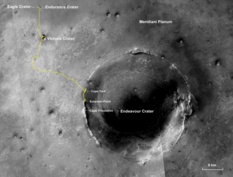
The adventure so far
The gold line on this image shows Opportunity's route from her landing site, upper left, to the area it is currently investigating in the Solander Point segment on the western rim of Endeavour Crater. The base image for the map is a mosaic of images taken by the Context Camera on MRO, built and operated by Malin Space Science Systems. This traverse map was made by Larry Crumpler, a MER science team member, of the New Mexico Museum of Natural History & Science, Albuquerque. If all goes as planned, Opportunity will depart for Cape Tribulation in coming months where it will ground-truth a mother lode of clay minerals in the most ancient landscapes any rover has traversed.NASA / JPL-Caltech / MSSS / NMMNHS
Once she wraps investigations at Cook Haven, it won't take Opportunity long to get the next site. The rover could scoot 60 meters or so down to the Bench, the flat, apron area surrounding the crater rim sections – on the west side of course since the east side is steep and rocky. Once on the Bench, the rover could zip along what effectively is a Martian "highway." Or she could continue along ridge. The decision will be made in coming sols.
Either way Opportunity is ready and as April begins, it's full steam ahead for MER. Plans call for the rover to drive into April, on her Sol 3621 (April 1, 2014). No fooling. And given all her newfound energy and increase in activities, the team will likely begin scheduling some a.m. passes with Odyssey to keep the data flowing off the rover and back to Earth.
"The vehicle continues to be in great health," said Callas. "The dust factor is the big news right now. We're very happy about that. It's very good and a great place to be as we start our next extended mission."
Although Opportunity hasn't even started the trek to the site 600 meters to the south, the scientists have long had their eyes on a more distant site, 2500 meters further south at Cape Tribulation. That's where they know the mother lode of smectites exists. "There's a valley that cuts right though Cape Tribulation and the walls are full of different kinds of clay," enthused Arvidson. "And they're all old rocks. The fact that you can see the third dimension means we can look at the bedded plains and the strata proper and can see the style alteration. Because we have the Bench, which is like a super highway, Cape Tribulation is not that far away."
"We are in wonderful shape and everyone is really excited about continuing the exploration on Solander and then down to Cape Tribulation," concluded Nelson. "And we are well poised to do that."
Support our core enterprises
Your support powers our mission to explore worlds, find life, and defend Earth. You make all the difference when you make a gift. Give today!
Donate

 Explore Worlds
Explore Worlds Find Life
Find Life Defend Earth
Defend Earth


